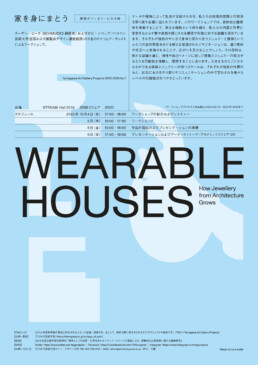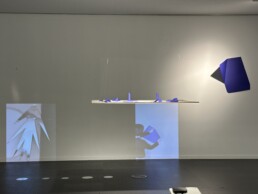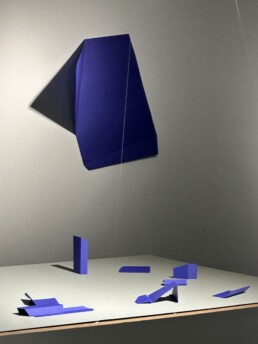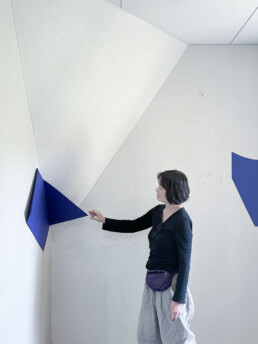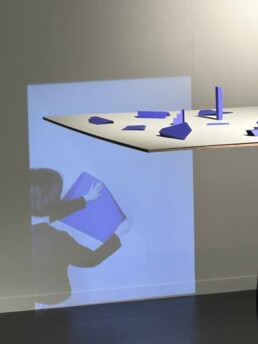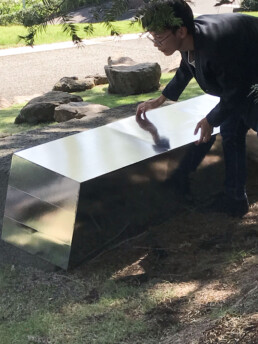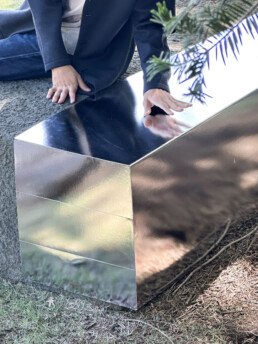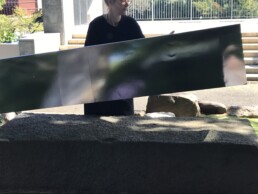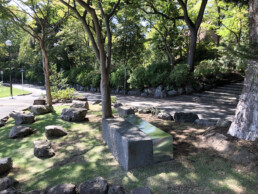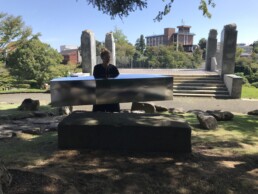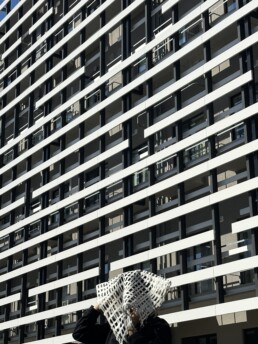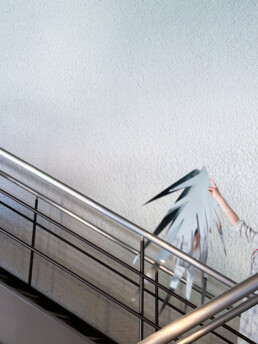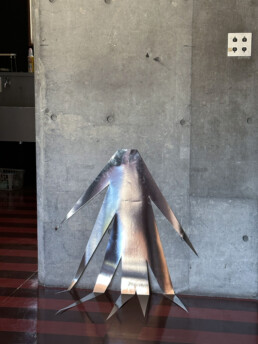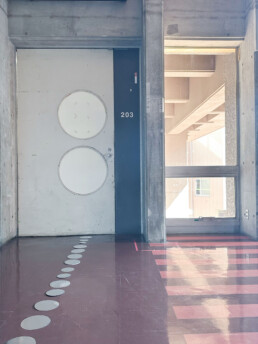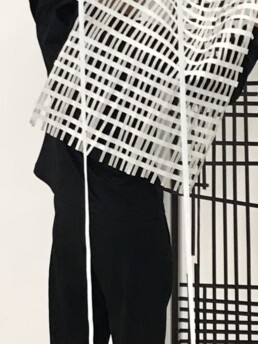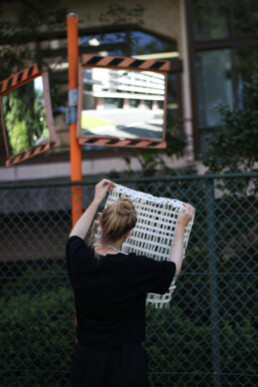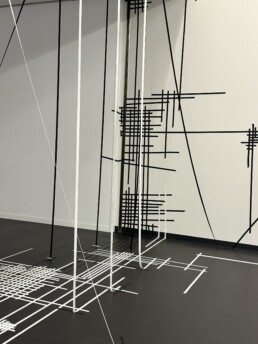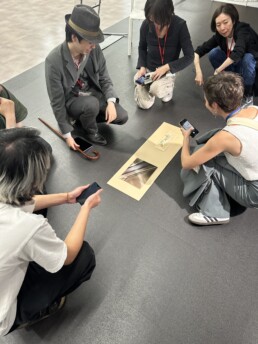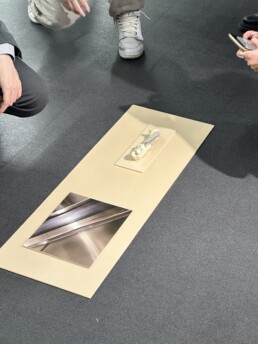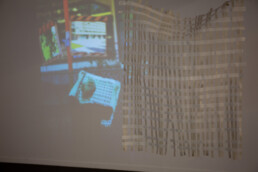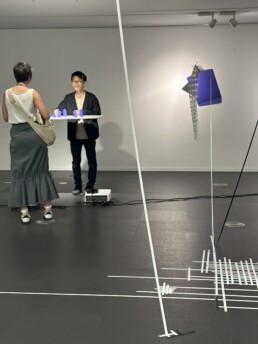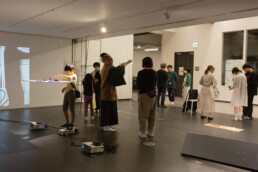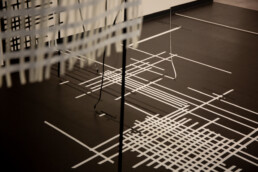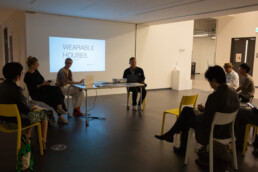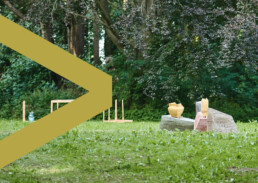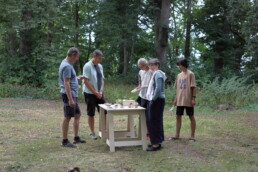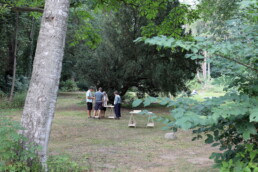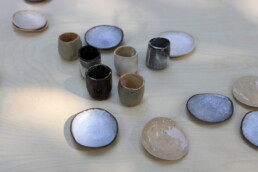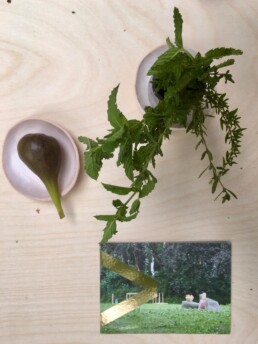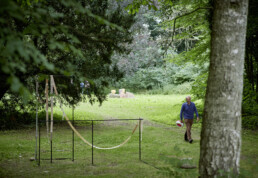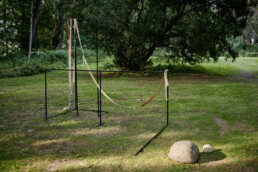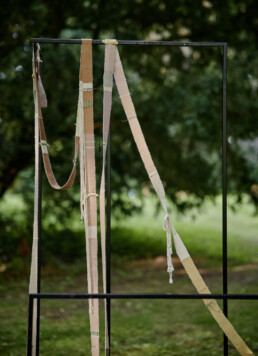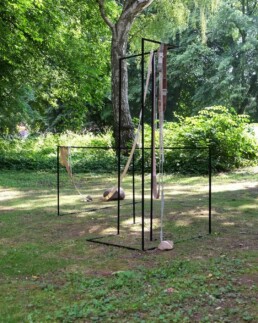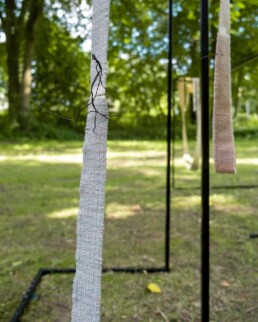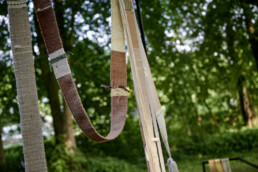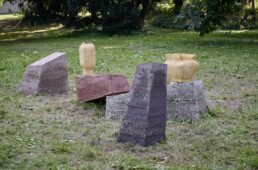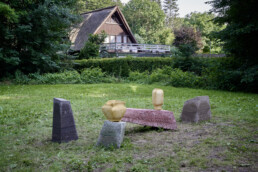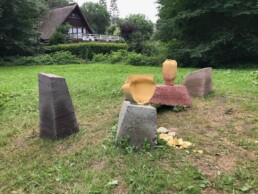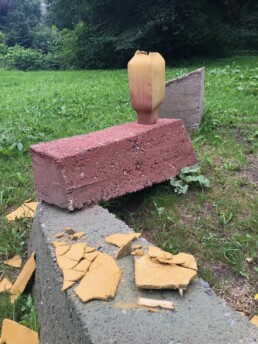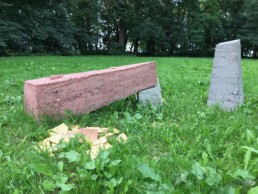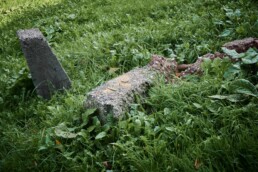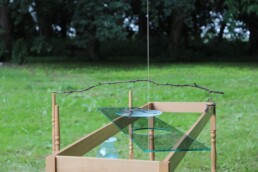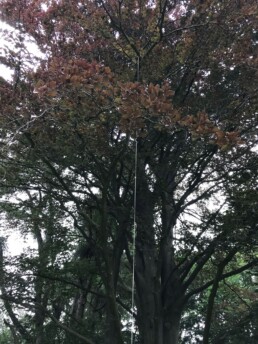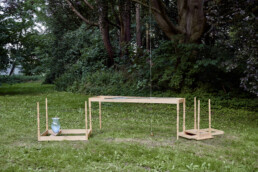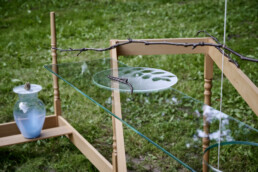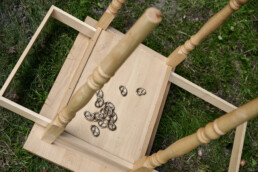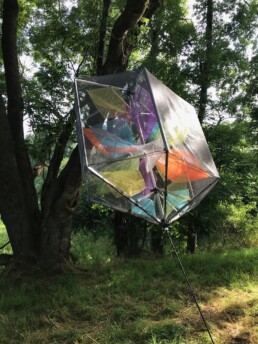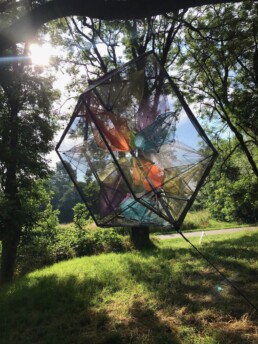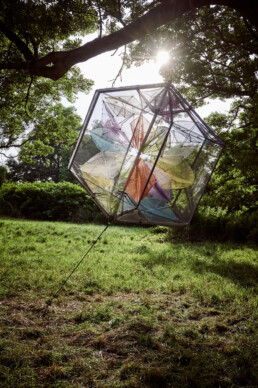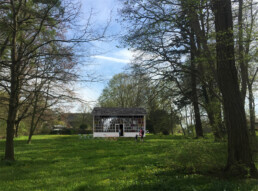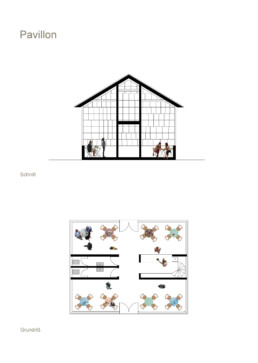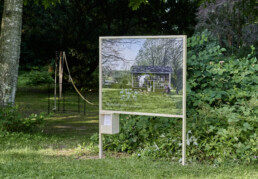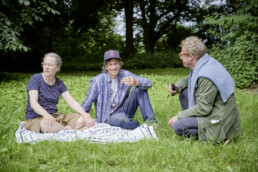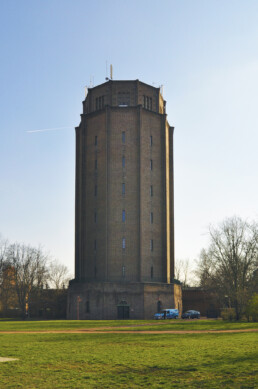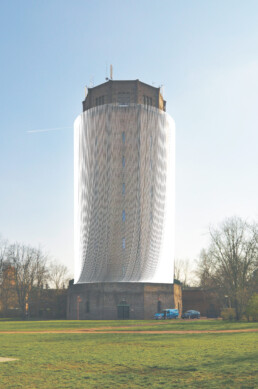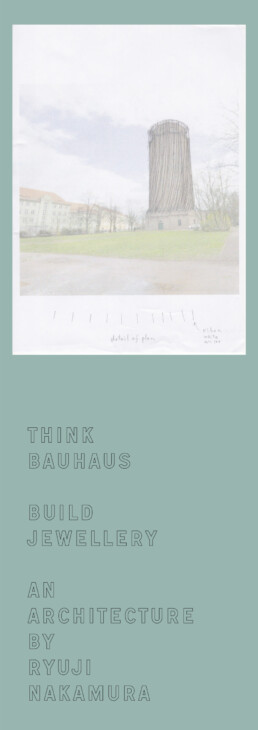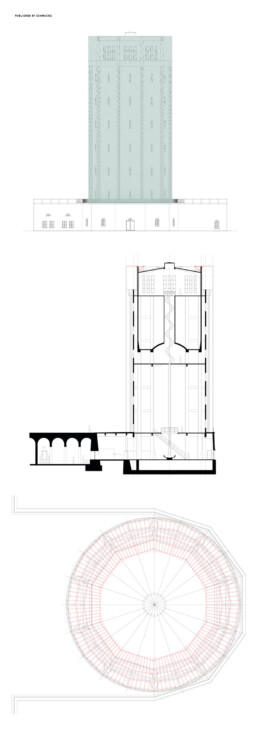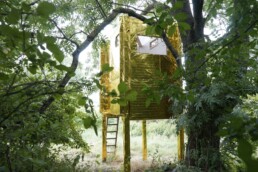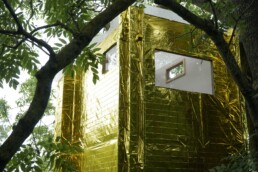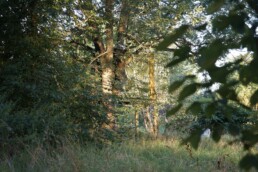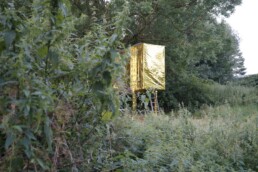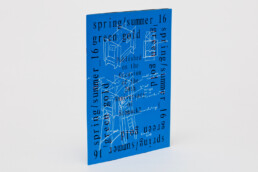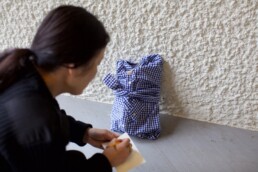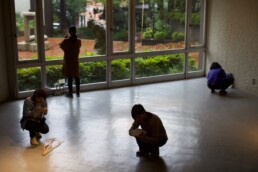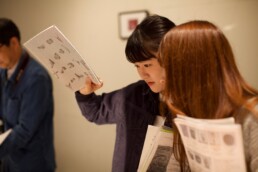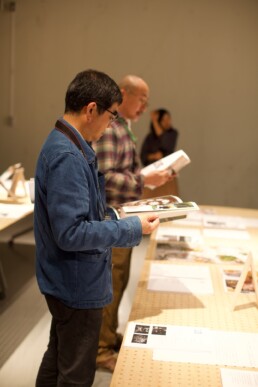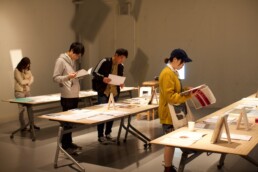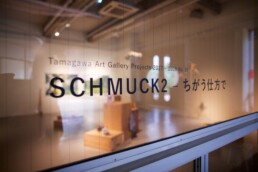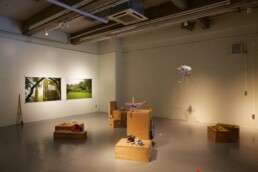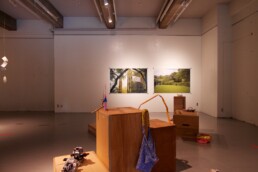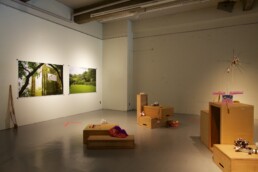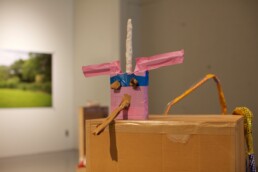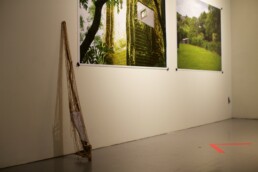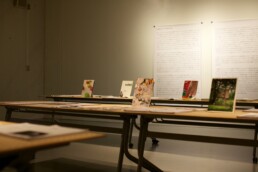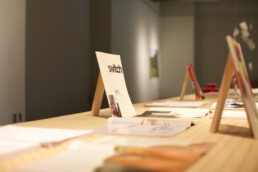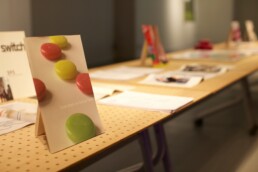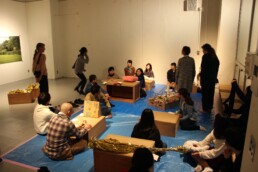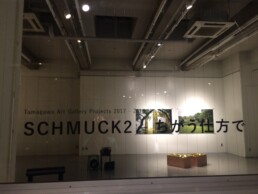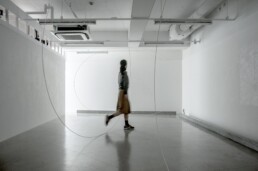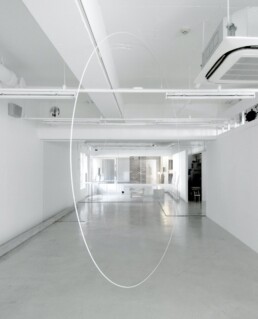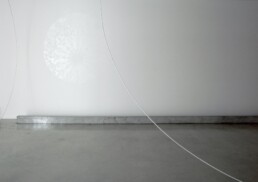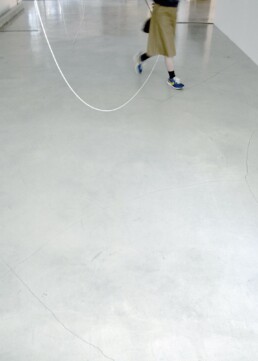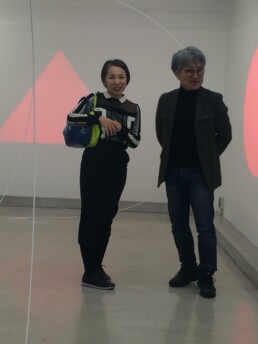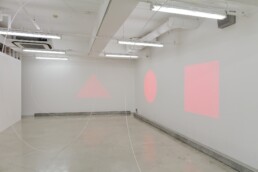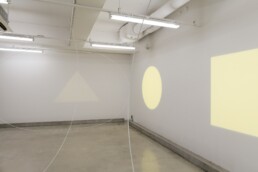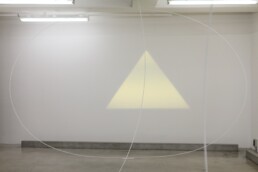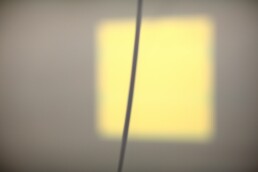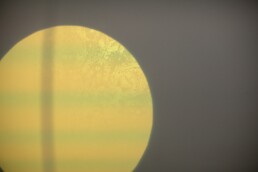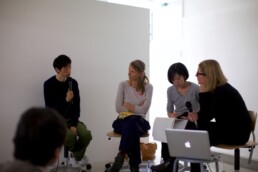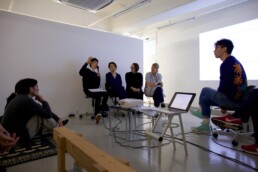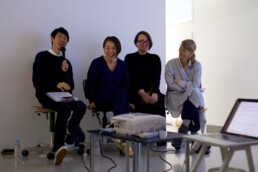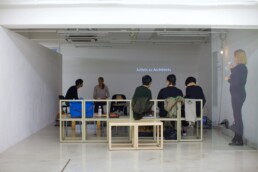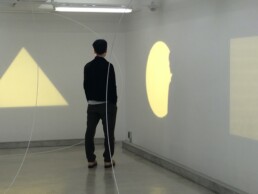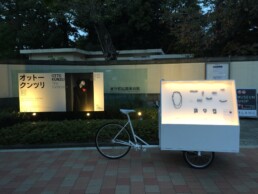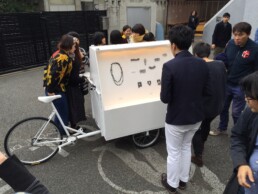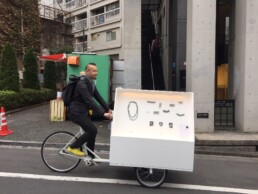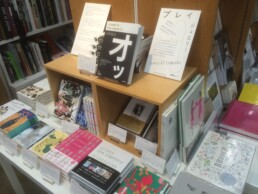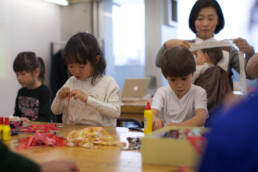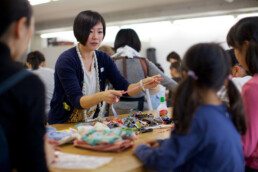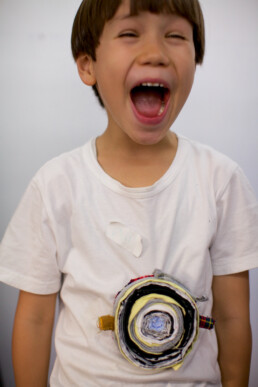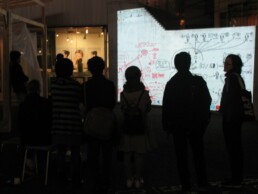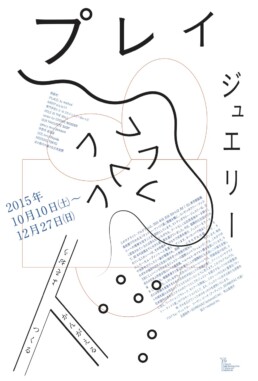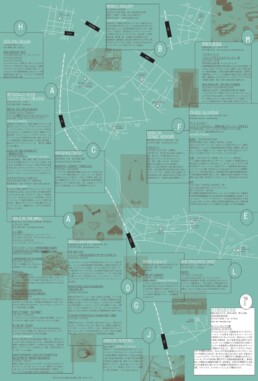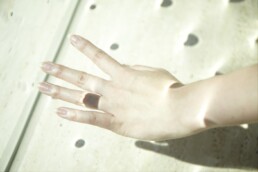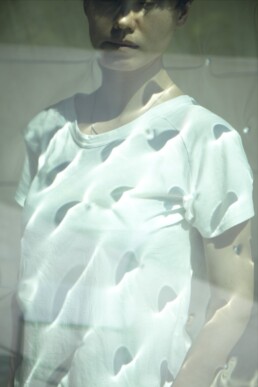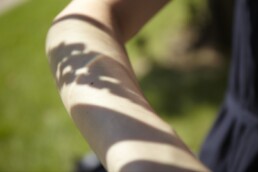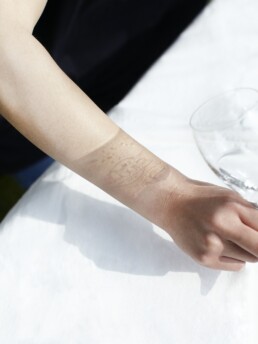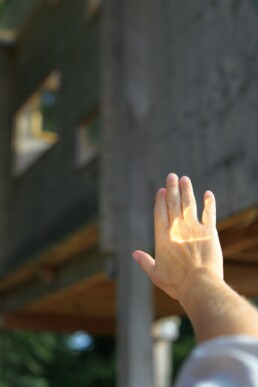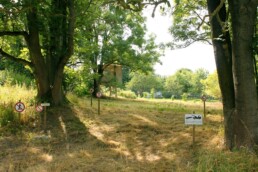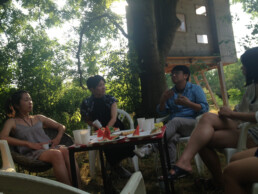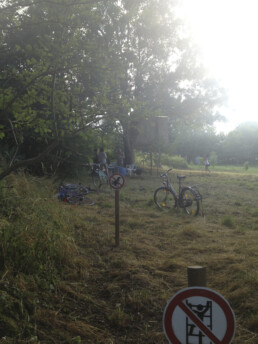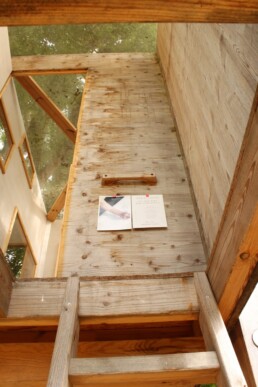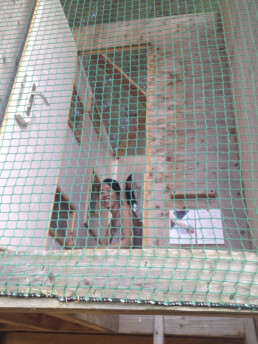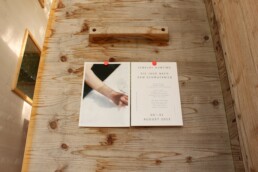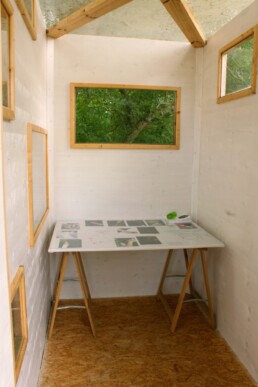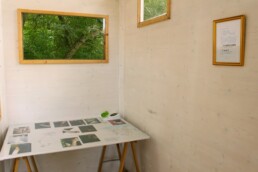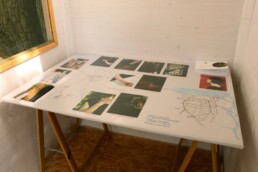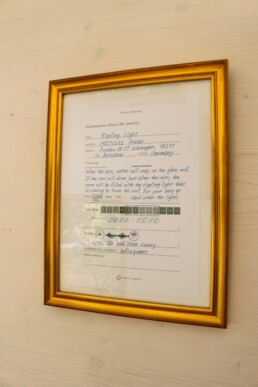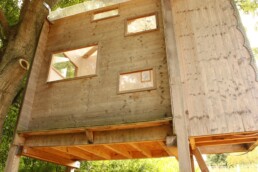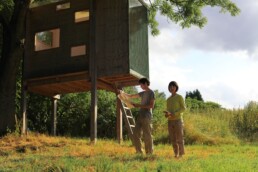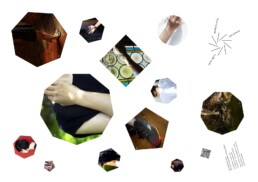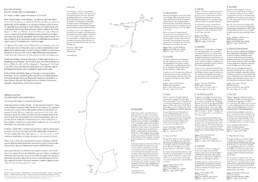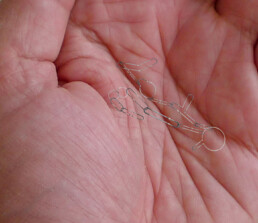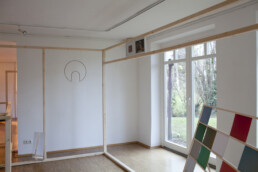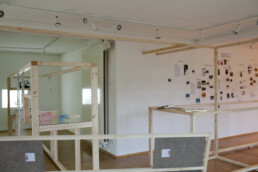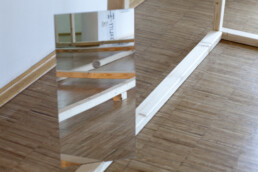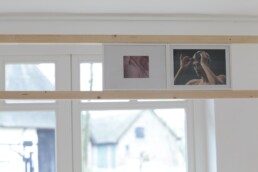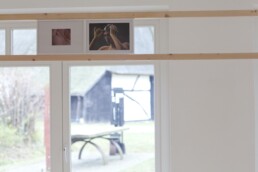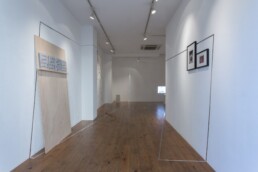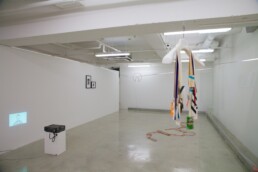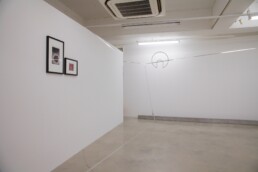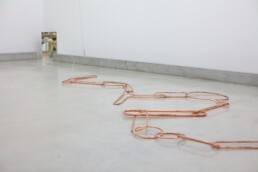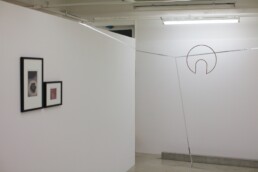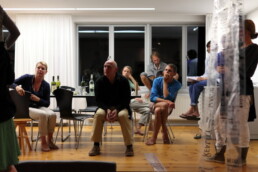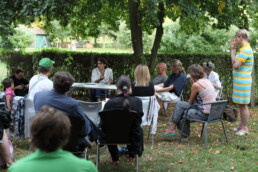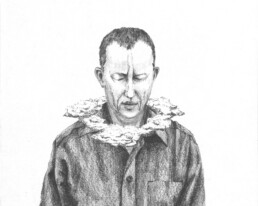WEARABLE HOUSES
24
2023
WEARABLE HOUSES
How Jewellery from Architecture Grows
家を身にまとう
As part of the TAG (Tamagawa Art Gallery) projects, Susan Pietzsch (SCHMUCK2) and Gabi Schillig (Studio for Dialogical Spaces, Berlin & professor for Spatial and Exhibition Design at the Berlin University of the Arts) led a workshop in October 2023 at Tamagawa University Tokyo.
Presentation view / photo© Susan Pietzsch + Gabi Schillig
At a time when information and data dominate our lives, there is an urgent need to re-engage with the physical space, the corporeal, and things that may be changeable and dynamic yet hold a continuous form. We make a conscious turn towards the material to stabilize our lives and connect as a tangible community.
The physical and the beautiful are both concretely present in the categories of architecture and jewellery. The physical provides the fundamental anchor of our lives, while the beautiful gives our lives support beyond function. Both are uniquely related to the human body, having direct influence and dependence on our inner and outer worlds.
Although architecture and jewellery are perceived very differently, both have the ability to articulate identities, and to stimulate, enable or represent communication.
In contrast, architecture and jewellery articulate and relate to the human body in different dimensions and scales. At the same time, we ask ourselves where the body ends and where space begins – and whether this boundary even exists. What dimension can jewellery take on to become architecture and vice versa?
Work by Atsuko Ito / photo© Susan Pietzsch + Gabi Schillig
In this workshop, students developed an awareness of how aspects of jewellery can be perceived in the structures, forms and materialities of their immediate surroundings by exploring and appropriating concrete architectural situations.
Work by Shunsei Yoshida / photo© Susan Pietzsch + Gabi Schillig
By transferring designs to other materials and playfully testing the effectiveness of changes in scale and dimension, participants placed their study of objects in relation to the human body. They then placed both of these together once more into the starting point of the experimental investigation, namely, the context of the architectural space.
Work by Hiyu Hamasaki / photo© Susan Pietzsch + Gabi Schillig
To gain a more multi-layered understanding of jewellery and architecture, Pietzsch and Schillig used themes such as beauty, ornamentation, and decoration as the basis for the investigation. In what ways is the depth and meaning of beauty manifested in jewellery and architecture?
Work by Haruka Sato / photo© Susan Pietzsch + Gabi Schillig
Within jewellery and architecture there is a graduated scale with a subversive quality of its own, from large to very small, that can be used for multifaceted modes of action in social togetherness.
Work by Hiyu Hamasaki / photo© Susan Pietzsch + Gabi Schillig + TAG projects
The goal for participants was to experience and understand the potential for their own personality and self-image through new perceptions, creativity and imagination.
Work by Kazuki Nishinaga / photo© Gabi Schillig
photo© Susan Pietzsch + Gabi Schillig + TAG projects
PLAY MUSEUM SCHMUCKBAR
23
2022
»Kunst ist ein freies Spiel, das Mitspielen verlangt. Jedes Werk ist für jeden, der es aufnimmt, ein Spielraum, den er ausfüllen kann.« (Hans-Georg Gadamer, Die Aktualität des Schönen: Kunst als Spiel, Symbol und Fest.)
© Copyright SCHMUCK2 + Thomas Häntzschel/nordlicht
On the occasion of its 25th anniversary in summer 2022, SCHMUCK2 has added to the PLAY MUSEUM project what belongs to every museum: the active encounter with the guest.
In spontaneous and conceived exchanges, SCHMUCK2 continued the vision of the »(jewellery) museum« and invited guests to the PLAY MUSEUM SCHMUCKBAR to experience the most elemental part of our lives – our food – in its representative and decorative quality. Directly connected to the body, our food serves us in an increasingly digitalized world, as one of the last important material basis of life. At the same time, with every bite, we promote the strengthening of our self-esteem, cultivate self-respect and self-care, qualities that are necessary to sustain life.
© Copyright Shintaro Imai
Artistically, the PLAY MUSEUM SCHMUCKBAR formed from the landscape, vegetation and what grows from it, their colors, shapes and flavors. Edible, pictorial sculptures were created, which changed in the process of presentation and emerged as projection objects for the beautiful, the nourishing, the adorning.
According to British curator and author Jasper Sharp, museums are places of collective experience that help connect us to one another. Ideally, they open up spaces for encounters and places for dialogues across borders.
The deliberate, mindful process in which the PLAY MUSEUM SCHMUCKBAR unfolded, was a quality that made it possible to enter into conversation with each individual visitor, to engage them in a reflective discourse.
© Copyright Shintaro Imai & Caroline Bayer
PLAY MUSEUM SCHMUCKBAR a performative intervention by Caroline Bayer and Susan Pietzsch on the occasion of 25 years of SCHMUCK2 in the park of the old Glashagen estate.
The project PLAY MUSEUM SCHMUCKBAR was funded by the Ministry of Science, Culture, Federal and European Affairs of Mecklenburg-Vorpommern and supported by the municipality of Retschow.
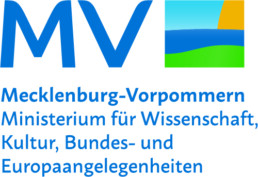
PLAY MUSEUM
22
2021
Under the banner PLAY MUSEUM, SCHMUCK2 picked up the focus on architecture and jewellery from its previous project and developed a utopian contemporary „(jewellery)museum“. This project concerned itself less with planning a new building and more with drawing the vision of a museum with a series of artistic installations, actions and new digital presence.
© Thomas Häntzschel/nordlicht
With the installation of the HOCHsitz as a »hypertransmitter« (Glashagen MV) and the associated »HOCHsitzen« publication of interviews in 2010, SCHMUCK2 posed the question of the contemporary location for artistic production and action. In projects such as PLAY JEWELLERY – WEAR ARCHITECTURE: Thinking about jewellery through architecture« (Tokyo 2015) or »THINK BAUHAUS: Building Jewellery in Architecture« (Halle and Tokyo 2019), SCHMUCK2 has iteratively juxtaposed architecture and jewellery in relation to each other. The theory that architecture stands symbolically as an ornament for its surroundings (Toshimasa Sugimoto/Architectural Historian) developed finally within this discourse.
With the pandemic in the background, the ways in which we install and organize exhibitions are changing, as well as how we receive and experience them. The new forms in which content is presented — digital/real, global/local, sustainable and participatory — are also changing the architecture in which this presentation takes place: it is moving from a fixed fortress to a flexible action. In the case of PLAY MUSEUM, the architecture — the designed and bounded space — is now lost in the action, turning its role from lodge to lodger.
Keeping the format of a classical exhibition, the artists Caroline Bayer, Kai Schiemenz, Asako Shiroki, Stefan Wischnewski, as well the architect Tom Kühne, developed and installed „architecture“ or „architectural gestures“ in the midst of the Mecklenburg landscape — in the park of the old Glashagen estate and next to the HOCHsitz that, following Sugimoto’s proposal, can be interpreted as jewellery.
© Caroline Bayer, Thomas Häntzschel/nordlicht
Caroline Bayer
STREAMER / plant-dyed wool (Xanthoria Parietina, Salix Salix), found objects, foundlings, powder-coated steel / 2021
For the work Streamer Caroline Bayer worked with the locally found lichen Xanthoria Parietina. In fermentation processes lasting several weeks, this lichen reacts similarly to indigo when dyed: shades ranging from light pink to pink can be achieved on wool.
Bayer took advantage of this and then wove the dyed wool into long ribbons, which she placed almost decoratively in a fragmentary spatial situation made of steel. The implied architecture functions as a linear drawing in space. It was created in reference to the modular display system Leger und Träger developed by the architect Friedrich Kiesler in 1924. It makes it possible to present exhibits without the aid of walls and to realize exhibitions independently of the room. Bayer took up Kiesler’s design and developed a system of linear steel modules that can be repeatedly assembled to create new forms and spaces.
© Susan Pietzsch, Thomas Häntzschel/nordlicht
Kai Schiemenz
Ane Titec (im Park)/ gravel, soil, clay, pigments / 2021
„A small park with trees. A meadow where there was a manor house. A path passes by it, which itself does not provide access to it. The park is embedded in a landscape of meadows, fields and farmsteads. In the movement of its paths dwells a little theater, a movement that visitors follow. If we see the park as a museum that collects and sorts things, then the meadow speaks of the absence of the manor house.“ (Kai Schiemenz 2021)
Kai Schiemenz has created an ephemeral and equally sustainable sculpture on site from clay, earth, gravel and pigments. Water was added to compact molds in formwork, which, once removed, served first and foremost as a display for unfired vessels made of clay, shaped by the artist. At the same time, the tamped earth was weather-dependent and thus subject to a natural process of decay.
The ephemerality became part of the sculpture and thus recalled the history of the site.
According to Schiemenz, it is not possible to say unequivocally in this regard whether the process of bringing forth and that of decay is not the actual sculpture.
© Asako Shiroki, Thomas Häntzschel/nordlicht
Asako Shiroki
A twig of interweaving passages / wood, glass, silver chain, bronzes / 2021
„One day I was walking on the street, I found charming shapes of the twigs. As I had one of them in my hand, I spotted a bird’s nest over my head. It was the moment of intervening between rational collection and destined accumulation, and it was the moment of discovering passages and interweaving different worlds. A charming shape of the twig was the connection of autonomous existence. I felt that we exist in our time with many different layers of the world.“
In her work, Asako Shiroki dislocates mutual rules and assigns new relationships to events that occur simultaneously in this world. History and culture, customs, awareness of flora and fauna, also the physical phenomena between tangible and intangible things are twisted and mixed by her. She reverses and mix things-including concepts-that by rights ought to be on the reverse, reflect things in mirrors, or peel away related meanings to let things themselves start a dialogue in different contexts. Different languages are translated, folded and layered with fictions and realities in a moment that leads us to a world in which they are equated.
Not without reference to the immediate environment, the artist has turned museum content on its head for PLAY MUSEUM, without neglecting concepts such as beauty and poetry against the actual background of the project.
© Susan Pietzsch, Thomas Häntzschel/nordlicht
Stefan Wischnewski
Interspace / laundry spiders, fly hoods, mosquitonets, aluminium / 2021
The seemingly floating sculpture made of laundry spiders, fly hoods and mosquito netting is already by its material origin, naming and function on the interface between nature, animal and man. The synergistic effect of a semi-transparent appearance in this rural environment sharpens the perception on the place, which is transformed into an open air showroom. The encounter with the self-contained net sculpture and the artificial complimentary colored fabric objects moving inside, allows a closeness at a distance, familiar from museum spaces.
© Tom Kühne, Thomas Häntzschel/nordlicht
Tom Kühne
Wandelhalle Glashagen – an architectural vision for the park of the old Glashagen estate / 2021
Using the means of looking back at the history of Glashagen-Hof, taking stock and formulating the potential available on site, Kühne developed the vision of a meeting/exhibition/event venue for, among other things, regional building culture in the form of a pavilion with coffee facilities on the vacant site of the former manor house.
© Thomas Häntzschel/nordlicht, Inga Knölke
> Play Museum proposes the museum as an argument, with an architecture made of theory: flexible, volatile, undulating and capable of sheltering, hosting and generating content to put it into reality.
The diagram shows a step-by-step dynamic management of actions defining the areas of performance and influence, with the intention of promoting architecture and jewelry in a critical and speculative setting to generate working models. In the pages of the book >Play Museum an initial drawing advances towards a diagram and ends up as a map of the museum on a picnic blanket.
Diagram of the >Play Museum concept by Martí Guixé as a map of the museum on a picnic blanket.
© Studio Martí Guixé
The project PLAY MUSEUM was funded by the Stiftung Kunstfonds within the program NEUSTART KULTUR, supported by Makra Bau GmbH and the municipality of Retschow.
Think Bauhaus. Building Jewellery in Architecture
21
2019
The historic Bauhaus, which celebrated its 100th anniversary in 2019, is recognized today as the most influential educational institution in the field of architecture, art and design of the 20th century. The Bauhaus Manifesto, written by Gropius in April 1919, articulates the objectives of the Bauhaus, which include among others “to unite architecture with art and design in the service of man as a social being” (W. Franks). Within this document, Gropius describes The Building as “the ultimate goal of all visual arts” ensuing that “the ornamentation of the building was once the loftiest task of all visual arts, as they were indispensable parts of great architecture. Today the arts exist in isolation, from which they can be rescued only through the conscious, cooperative effort of all craftspeople.”
The project “Think Bauhaus. Building Jewellery in Architecture” sought a contemporary interpretation of Gropius’ way of thinking. In so doing, the project was in no way about decorating a building devoid of consideration of its architecture; rather, it was much more about a visionary interpretation of the concept of jewellery in architecture following the idea of Bauhaus and its relevance in our present time.
A project inspired from an idea developed by SCHMUCK2, was originally designed for the parking garage and water tower in Halle, as well as the Deaconess Motherhouse “Neuvandsburg” in Elbingerode (Harz), in cooperation with the Saxony-Anhalt Arts Foundation. It was presented in two competitions by the Saxony-Anhalt Arts Foundation. Ultimately the design “Reif“ created by the Japanese architect Ryuji Nakamura remained unrealized.
Within the program “Bauhaus – Open End” at the Goethe Institute Tokyo a public talk was held with Torsten Blume (Researcher, Bauhaus Dessau Foundation) + Toshimasa Sugimoto (Architectural Historian, University of Hiroshima) + Ryuji Nakamura (Architect). Moderated by Susan Pietzsch.
© Photo/Rendering by Ryuji Nakamura + Posters from the publication Think Bauhaus. Build Jewellery in Architecture
The water tower in Halle South was built in 1927-29 by Wilhelm Jost and Oskar Muy (Wayss & Freytag). Although it is a water tower where people usually don’t stay for a longer time the building has decorative features like for example, a reinforced concrete structure covered with bricks, or inside the tower a decorative pendant light, even a water fountain. Expressionism and functionalism coexisted in early Bauhaus architecture, as can be seen in the tower. For the project “Think Bauhaus. Building Jewellery in Architecture”, Japanese architect Ryuji Nakamura planned a covering of the tower with silk ribbons symbolizing decoration. The ribbons were to cover the entire building, similar to the works of Christo and Jeanne-Claude or even a dressed person. The cylindrical shape is inspired by the dance costumes designed by Oskar Schlemmer. The water tower covered with the ribbons creates a chance to reaffirm the sense that ordinary appearance of the water tower gives to the people of the city.
„Reif“ by Ryuji Nakamura and Associates 2019 (φ20.50m H33.85m – Unbuilt)
spring/summer 16_green gold
20
2018
In 2016 the two German artists Susan Pietzsch and Valentina Seidel started their project spring/summer 16_green gold at the HOCHsitz. For a week the two artists wrapped the studio in golden foil.
A temporary installation and performance that challenges gold both in art and in the context of jewellery. At the same time, however, the work also questioned places for artistic productions and interprets the concept of architecture in interplay with jewellery. Nestled in a place of yearning, for a limited time, the resulting photographic work is the artistic product that is preserved.
„For a brief moment, Valentina Seidel and Susan Pietzsch infiltrated something inexplicable into the realm of reality and created a puzzling space full of poetry in the midst of nature. Fleeting gold.“
On the occasion of the 20 years celebration Schmuck2 published a series of photographs from the project spring/summer 16_green gold by the two German artists Susan Pietzsch and Valentina Seidel.
The picture booklet is accompanied by a textbook including texts by Anne Schloen, Makiko Akiyama and an interview by Benjamin Lignel in conversation with Susan Pietzsch.
spring/summer 16_green gold – a publication on the occasion of 20 years of Schmuck2 (1997-2017)
© Photo Inga Knölke
Funded by the Ministry of Culture of Mecklenburg-Western Pomerania.
SCHMUCK2 - the praxis differs
19
2017
On the occasion of the 20th anniversary of SCHMUCK2 in 2017, the exhibition “SCHMUCK2 – the praxis differs” gave an overview on the projects of the past 20 years through a composable archive in DIY format .
In cooperation with Esther Gleuwitz (Academy of Fine Arts Nuremberg/ Jewellery Department) and Marguerite Bones (Gerrit Rietveld Academie Amsterdam/ Jewellery Department) SCHMUCK2 initiated a workshop “re-evaluate the given and taken” in parallel to the exhibition at the TAG – Tamagawa Art Gallery in Tokyo, Japan.
© Susan Pietzsch, Shunsuke Minami, Shintaro Imai
The workshop did focus on our daily objects and how we relate to them. During a limited time of the working session, participants did exchange, react to, and reveal their impressions within the context of jewellery. Works produced within the workshop became a completive part of the exhibition.
Wear Architecture
18
2015
How do jewellery and architecture relate, and what can they learn from each other? This exhibition looked to answer that question as part of the satellite program PLAY JEWELLERY – wearing, making, thinking in coincidence with the Otto Künzli exhibit at the Tokyo Metropolitan Teien Art Museum.
The project which continues further, started of with an exhibition by Japanese architects Yuko Nagayama and Ryuji Nakamura as a part of the satellite program PLAY JEWELLERY – wearing, making, thinking at (PLACE )by method in Tokyo(JP).
Nagayama and Nakamura investigated personal and public spheres to discover commonalities between architecture and jewellery and their possible interplay. They met with fellow architects Jo Nagasaka and Hideyuki Nakayama to discuss this topic beforehand in an open debate and a panel discussion. Their findings formed the foundation of this exhibit, which is part of a longer, ongoing project focusing on the relation between jewellery and architecture.
A panel of four architects; Yuko Nagayama, Jo Nagasaka, Ryuji Nakamura and Hideyuki Nakayama discussed topics that show a possible relation between jewellery and architecture.
The German art historian Dr. Anne Schloen and the Japanese architect Ryuji Nakamura discussed crossing lines between art and architecture based on their professional experience. Schloen recently co-organized the exhibition (im)possible! Artists as Architects, at the Museum Marta Herford (Germany). Nakamura is known for designing exhibition spaces and museum instillations beside his architectural approach.
PLAY JEWELLERY
17
2015
On the occasion of the Otto Künzli exhibition at Tokyo Metropolitan Teien Art Museum hold from October to December 2015, the program PLAY JEWELLERY – wearing, making, thinking was planned to promote the exhibition while offering a fresh viewpoint on jewellery through workshops, guest speakers, seminars and exhibits of the diverse styles of jewellery within Japan. PLAY JEWELLERY – wearing, making, thinking“ commissioned by Tokyo Metropolitan Teien Art Museum has been organized by SCHMUCK2 in cooperation with Makiko Akiyama and method Inc.
Curated in two parts; firstly the „main program“ and secondly the „recommended program“, the main program contained events such as the Mobile Gallery by Akihiro Ikeyama, the continuation of the Jewelry Hunt by Naoko Ogawa, the Jewellery Library by Makiko Akiyama, CECI N’EST PAS UN BIJOU – a lecture by the German art historian Dr. Anne Schloen, the screen of the SCALE OF RELATIONALITY by Monica Gaspar, Damian Skinner and Marti Guixe, the exhibition FLUX by Japanese artist Yusuke Ishikawa, the kids workshop „MAKIMAKIMAKI“ by Maki Kawawa and the SCHMUCK2 “kick off“ of the PLAY JEWELLERY – WEAR ARCHITECTURE project (including a public panel discussion and open debate as well a first exhibition by Ryuji Nakamura and Yuko Nagayama).
The “recommended program“ consisted of a large number of events developed by venues such as Center for Cosmic Wonder, Hole in the Wall, gallery deux poisson, OFS (OUR FAVORITE SHOP), Arts Chiyoda a.o., selected by the program organizers.
The “recommended program“ consisted of a large number of events developed by venues such as Center for Cosmic Wonder, Hole in the Wall, gallery deux poisson, OFS (OUR FAVORITE SHOP), Arts Chiyoda a.o., selected by the program organizers.
Jewellery Hunting
16
2013
A project by Naoko Ogawa in collaboration with SCHMUCK2.
Ogawa’s jewellery hunt is based on the connotation of individual beauty that exists only in our imagination. The artist’s goal is to initiate a hunt in which jewellery and the possession thereof is only experienced visually. Moreover, one is sensitised to the awareness of a new perception of worth.
According to Ogawa, the possession of worth is the most meaningful element of each person, because it is what constitutes the respective individual personality. Similar to the possession of a car, a clock, a work of art, or a house, jewellery is considered to be a specific indicator of self-expression in our society. The artist alludes to this idea in her jewellery hunt.
In Ogawa’s project Jewelry Hunting – Die Jagd nach dem Schmuckbild, a fleeting image of jewellery is captured, existing only for the moment. For this, the artist makes use of various lighting effects and apparitions. Thus, glowing light, diffused light, light fragments, or a stark colour contrast, as well as silhouettes or casted shadows can be pieces of jewellery in the sense given by the artist.
Visitors can go on the jewellery hunt themselves by means of a field map on which the artist has defined possible places to hunt down jewellery in the area of Bad Doberan/Rostock.
Point of departure for the hunt was the HOCHsitz Atelier. A piece of jewellery from a successful hunt could be captured in a picture, or just carried home in one’s memory.
Get your field map and start your hunt from the HOCHsitz!
© Naoko Ogawa
Naoko Ogawa studied at the Tokyo National University of Fine Arts and Music in the master class for metalwork. She was then a research student at Tama Art University in Tokyo, where she completed her Bachelor’s in the metal class. She has participated in numerous international exhibits and presented her most important solo show to date in 2011 at the Galerie Biro in Munich. In contrast with most jewellery artists, Ogawa develops jewellery as an object for which the meaning of the wearing of jewellery also plays a significant role. The motivation for her work is the piece of jewellery that is completed only through its being worn. Naoko Ogawa lives in Berlin.
Jewellery Hyperreal
15
2012/2014
The point of departure for the workshop and the exhibition took its shape from the views of the Spanish designer Marti Guixe, who stated the following in a 2011 interview with SCHMUCK2:
“I think at the moment that jewellery’s purpose is to be only a picture—not a reality—and in that way it can be present without being made. (…) Something like haute couture, you see it everywhere but nobody wears it.” And “Jewellery should go beyond material and handicraft. (…) This could be plastic surgery, or text, or whatever that could be added into your image, figure or composition of the photo or video.”
from: “Hochsitzen”, published by SCHMUCK2, 2011
The workshop at Künstlerhaus Lukas and the following exhibition at Neues Kunsthaus Ahrenshoop involved artists and designers Gabriele Altevers(DE), Caroline Bayer(DE), Karla Detlefsen(DE), Benedikt Fischer(NL), Marti Guixe(ES), Inga Knölke(DE), Tom Kühne(DE), Susan Pietzsch(DE), Anne Schloen(DE) and Wolfgang Stehle (DE) called attention to this development. Artists did deal especially with the questions: Does the emergence of hyperreality also have an effect on the human need for adornment? What significance does the existence of a hyperreality hold for the concept of jewellery? Can jewellery be transported into a hyperreal existence?. Excerpts of the project had been on show at the exhibition space (PLACE ) by method in Tokyo(JP) and studio J in Osaka(JP).
“JEWELLERY HYPERREAL” – How could jewellery be transferred into hyperreality?
Book launch and exhibition 04th – 19th of april 2014 at (PLACE ) by method, Tokyo
26th of april – 24th of may 2014 at studio J, Osaka, featuring art works from the workshop during August 2012 at Künstlerhaus Lukas Ahrenshoop by Marti Guixe/ Inga Knölke/ Susan Pietzsch/ Wolfgang Stehle.
Funded by the Ministry of Culture of Mecklenburg-Western Pomerania and the County North Pomerania.
